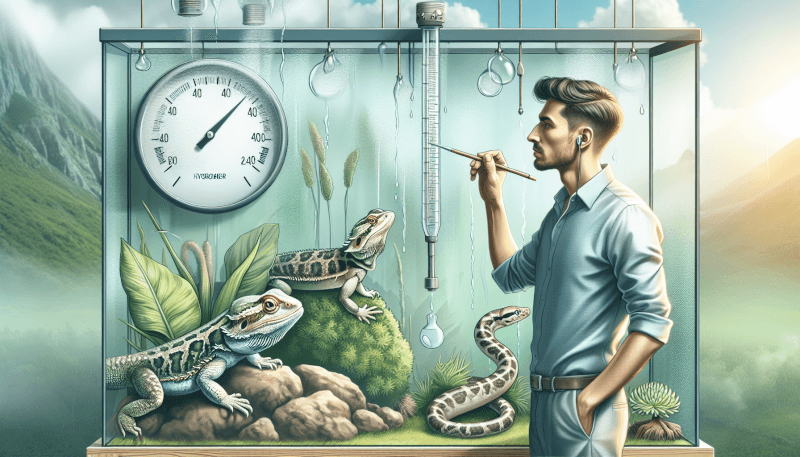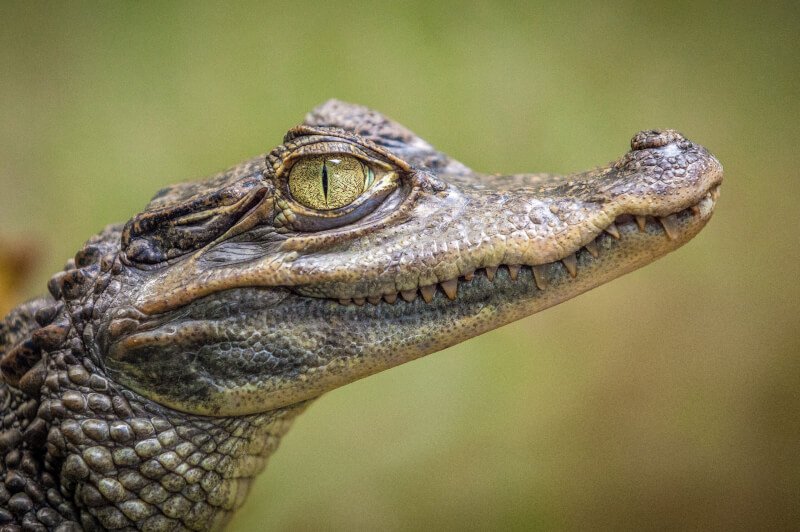Making sure your reptile’s enclosure has the right humidity levels is crucial for their health and well-being. The proper humidity levels are vital for maintaining healthy skin, shedding properly, and overall respiratory function. In this article, we will explore the importance of humidity control and provide you with some tips on how to maintain the perfect levels for your reptile friend.

Understanding the Importance of Humidity for Reptiles
The role of humidity in a reptile’s health
Humidity plays a vital role in the overall health and well-being of reptiles. Reptiles, being ectothermic creatures, rely on their environment to regulate their body temperature. Humidity is a key factor in this process as it helps reptiles maintain their hydration levels and aids in various physiological functions.
Why proper humidity levels are crucial for reptiles
Proper humidity levels are crucial for reptiles as they have specific humidity requirements that are essential for their overall health. Reptiles come from diverse habitats, ranging from arid deserts to humid rainforests, and their humidity needs are closely tied to their natural environments. Maintaining proper humidity levels helps replicate their natural habitat, ensuring that reptiles can thrive in captivity.
How improper humidity can affect a reptile’s well-being
Improper humidity levels can have a negative impact on a reptile’s health and well-being. Insufficient humidity can lead to dehydration, difficulty shedding, respiratory problems, and other ailments. On the other hand, excessive humidity can cause bacterial and fungal infections, skin conditions, and contribute to stagnant moisture, creating an unsuitable environment for reptiles. Therefore, understanding and maintaining proper humidity is vital for ensuring the overall health and longevity of reptiles in captivity.
Factors Affecting Humidity Levels in Reptile Enclosures
Natural habitat and species-specific requirements
One of the primary factors influencing humidity levels in reptile enclosures is the natural habitat of the species. Different reptiles require varying levels of humidity based on their origin and unique adaptations. For instance, tropical reptiles such as chameleons and tree boas need higher humidity levels, while desert-dwelling reptiles like bearded dragons and leopard geckos require lower humidity levels.
Size and type of enclosure
The size and type of enclosure play a significant role in determining humidity levels. Larger enclosures tend to retain moisture better, allowing for a more stable humidity environment. Enclosure materials also affect humidity levels, as certain materials may absorb or release moisture. It is important to choose enclosures that can easily be modified to maintain the desired humidity range.
Ventilation and airflow
Proper ventilation is crucial in maintaining the ideal humidity levels. Insufficient airflow can lead to stagnant humidity, increasing the risk of bacterial and fungal growth. On the other hand, excessive ventilation can cause rapid humidity loss. Finding the right balance in ventilation and airflow within the enclosure is essential for maintaining a healthy humidity level.
Temperature and heating
Temperature and heating directly impact humidity levels within a reptile’s enclosure. Higher temperatures increase the rate of evaporation, leading to decreased humidity levels. It is important to ensure that a reptile’s heating source does not continually dry out the enclosure. Additionally, using heat emitters or heat mats that do not directly affect humidity levels can aid in maintaining the desired humidity range.
Water sources and moisture
Water sources and moisture greatly influence humidity levels. Reptiles require access to fresh water that contributes to the overall humidity within their enclosure. Providing water bowls or misting the enclosure can help maintain humidity levels, especially for amphibious reptiles that require both land and water environments. Monitoring and replenishing water sources regularly are crucial for maintaining proper humidity.
Substrate selection and moisture retention
The choice of substrate can impact humidity levels within the enclosure. Some substrates, such as coco coir or sphagnum moss, are known for their moisture retention properties, helping to increase and stabilize humidity. Others, such as arid substrates like sand or reptile carpet, may result in lower humidity levels. Choosing a substrate that aligns with the reptile’s natural habitat and specific humidity requirements is essential for maintaining optimal humidity levels.
Monitoring and Measuring Humidity
Tools and equipment for monitoring humidity
To actively monitor humidity levels within a reptile’s enclosure, various tools and equipment can be utilized. Hygrometers, specifically designed for measuring humidity, are invaluable in obtaining accurate and real-time humidity readings. Digital hygrometers are widely available and provide precise measurements, while analog hygrometers offer a cost-effective alternative.
Ideal humidity ranges for different reptile species
Understanding the ideal humidity range for specific reptile species is crucial in maintaining their optimal health. Researching the natural habitat of the reptile species will provide insight into their humidity preferences. For example, tropical reptiles generally require humidity levels between 50% and 80%, while desert reptiles thrive in drier environments with humidity levels ranging from 20% to 40%.
Common methods for measuring humidity levels
Besides hygrometers, several other methods can be used to measure humidity levels within a reptile’s enclosure. One such method is the condensation test, which involves checking for droplets of water forming on the walls or glass of the enclosure. Another method is using the touch and feel technique by assessing the moisture content of the substrate. While these methods are convenient, they may not provide as accurate readings as hygrometers.
Regular monitoring and adjustments
Maintaining proper humidity levels requires regular monitoring and adjustments. It is important to frequently check the humidity levels using hygrometers and other measuring methods. If the humidity deviates from the ideal range for the specific reptile species, adjustments must be made promptly. Small changes can be implemented by misting the enclosure or adjusting the heating and ventilation systems, while larger adjustments may require modifying the enclosure setup.
Creating and Maintaining Proper Humidity Levels
Providing a water source or humidity chamber
One of the primary ways to create and maintain proper humidity levels is by providing a reliable water source within the enclosure. This can be in the form of a water bowl or a humidity chamber. Water bowls should be large enough for the reptile to soak in and maintain hydration. A humidity chamber can be created using a container filled with damp substrates, and the reptile can seek out the desired humidity by entering the chamber when needed.
Choosing appropriate substrates
Selecting suitable substrates that retain moisture is crucial in creating and maintaining proper humidity levels. Natural materials like coco coir, sphagnum moss, or orchid bark are excellent choices as they have high moisture retention properties. These substrates not only contribute to the overall humidity but also provide a more natural and comfortable environment for the reptile.
Misting and spraying techniques
Misting and spraying techniques are effective in increasing humidity levels within the enclosure. This can be done manually using a spray bottle filled with fresh water. Regular misting throughout the day helps simulate natural rainfall and raises humidity levels. Paying attention to specific areas in the enclosure where the reptile spends most of its time, such as basking spots or hideouts, ensures that they have access to optimal humidity levels.
Utilizing humidity-loving plants or moss
Introducing humidity-loving plants or moss into the enclosure can aid in maintaining proper humidity levels. These plants, such as pothos or ferns, release moisture into the air through a process called transpiration, naturally increasing humidity. Similarly, placing damp sphagnum moss in certain areas can act as a moisture source and contribute to overall humidity. However, it is important to select plants and moss that are non-toxic to reptiles.
Using humidifiers and foggers
Humidifiers and foggers are effective tools for creating and maintaining proper humidity levels, especially for larger enclosures or specific reptile species that require high humidity. These devices emit a fine mist or fog, providing a steady source of moisture throughout the enclosure. Humidifiers and foggers come in various sizes and models, ensuring compatibility with different types of enclosures and reptile habitats.
Creating microclimates within the enclosure
Creating distinct microclimates within the enclosure allows reptiles to regulate their exposure to humidity according to their preferences. This can be achieved by incorporating different substrates or creating specific areas with varying humidity levels. Heat mats or heat emitters can be strategically placed to create warmer and drier spots, while placing water bowls or humidifiers in other areas can provide higher humidity regions.
Avoiding excessive or stagnant moisture
While it is crucial to maintain proper humidity levels, it is equally important to avoid excessive or stagnant moisture within the enclosure. Excessive moisture can lead to bacterial and fungal growth, respiratory issues, and skin problems. To prevent this, allow the enclosure to dry out partially between misting sessions and ensure proper airflow and ventilation to avoid stagnant moisture pockets.
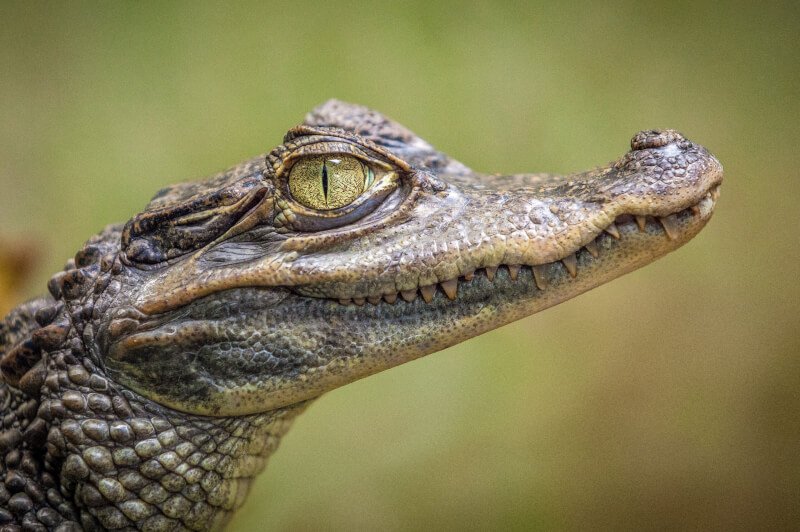
Preventing and Addressing Humidity-Related Issues
Common problems associated with high humidity
High humidity levels can lead to several problems for reptiles. Increased humidity may contribute to respiratory issues, such as respiratory infections and difficulty breathing, particularly in reptile species that require lower humidity environments. Additionally, high humidity can promote the growth of harmful bacteria and fungi, leading to skin infections and other health complications.
Signs of inadequate humidity
Reptiles that are not provided with adequate humidity levels may exhibit various signs of discomfort or poor health. Some common signs include excessive shedding difficulties, dry and flaky skin, irritated eyes or nasal passages, increased thirst or dehydration, and overall lethargy and poor appetite. Monitoring for these signs is crucial for identifying and addressing inadequate humidity.
Addressing high humidity levels
To address high humidity levels, several measures can be taken. Increasing ventilation within the enclosure, reducing misting frequency, and adjusting the heating elements can help decrease humidity levels. Using dehumidifiers or removing excess water sources, such as excessively damp substrates or water bowls, can also aid in decreasing humidity. It is essential to monitor the changes and ensure the humidity reaches the optimal range for the specific reptile species.
Solving low humidity issues
Low humidity issues can be resolved by implementing various strategies. Increasing misting frequency, using larger water bowls, or adding humidity chambers can help elevate humidity levels within the enclosure. Choosing appropriate substrates known for moisture retention and incorporating humidity-loving plants or moss can also contribute to maintaining higher humidity. If necessary, utilizing humidifiers or foggers can assist in raising humidity levels to the required range.
Importance of Humidity during Different Life Stages
Egg incubation and hatchlings
During egg incubation, maintaining proper humidity levels is crucial for the successful development of reptile embryos. Specific humidity requirements are necessary to ensure proper hydration and prevent desiccation of the eggs. Hatchlings also require optimal humidity levels to aid in their shedding process, as they often have delicate and sensitive skin that requires appropriate moisture.
Juveniles and growth
Juvenile reptiles are particularly vulnerable to humidity fluctuations, as they are still developing and growing. Maintaining the proper humidity levels during this stage is essential for their overall health and growth. Insufficient humidity can lead to stunted growth, dehydration, and compromised immune systems. Adequate humidity helps provide a conducive environment for juveniles to thrive and reach their full potential.
Adults and shedding
Adult reptiles require consistent and appropriate humidity levels to support their shedding process. Shedding is a natural process where reptiles shed their old skin to accommodate their growth. Inadequate humidity can result in incomplete shedding, leading to retained skin or difficulties in removing the old skin. Proper humidity ensures the skin can easily separate and slough off, preventing any potential complications.
Breeding and reproductive success
Proper humidity is crucial during breeding and reproduction for reptiles. It plays a significant role in maintaining the optimal conditions for successful courtship, egg development, and nesting behaviors. Incorrect or inadequate humidity levels during breeding and reproduction can negatively impact reproductive success, resulting in infertility, poor hatching rates, or even loss of embryos.
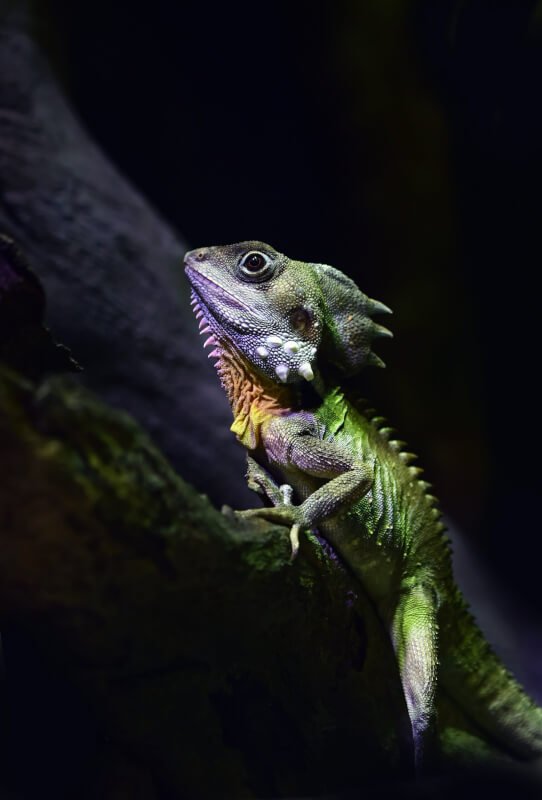
Seasonal Variations and Humidity Adjustments
Understanding humidity fluctuations throughout the year
Humidity levels naturally fluctuate throughout the year due to seasonal changes. It is important to be aware of these fluctuations and make necessary adjustments to maintain the proper humidity range for reptiles. For instance, humidity tends to increase during rainy seasons or in warmer months, while it decreases during drier and colder seasons.
Modifying humidity levels for different seasons
During seasons with higher humidity, such as summer or the rainy season, it may be necessary to reduce misting frequency or adjust ventilation to prevent excessive humidity. Conversely, in drier seasons or winter months, increasing misting and humidity sources can help maintain optimal humidity levels. Regular monitoring and adjustments based on seasonal variations are essential for the well-being of reptiles.
Effects of environmental changes on reptiles
Environmental changes, such as transitioning from outdoor to indoor enclosures or relocation to different climates, can significantly impact reptiles’ humidity requirements. Reptiles that are moved between different environments may experience stress and struggle to adjust to new humidity levels. It is important to gradually acclimate reptiles to their new environment and closely monitor humidity to ensure a smooth transition and continued health.
Humidity-Related Health Issues and Preventive Measures
Respiratory problems
Inadequate or excessive humidity can both contribute to respiratory problems in reptiles. Insufficient humidity can result in dry nasal passages and respiratory tract, while excessive humidity can foster bacterial and fungal growth in the respiratory system. Maintaining proper humidity levels and promptly addressing deviations can help prevent respiratory issues and promote respiratory health.
Dehydration and skin conditions
Insufficient humidity can lead to dehydration in reptiles, which negatively impacts overall health and various physiological functions. Inadequate moisture can cause dry and flaky skin, increased shedding difficulties, and irritation. Providing proper humidity levels and ensuring a consistent source of moisture can help prevent dehydration and maintain healthy skin condition.
Fungal and bacterial infections
Excessive humidity levels can create a favorable environment for the growth of harmful bacteria and fungi, leading to various infections in reptiles. These infections can manifest as skin conditions, respiratory infections, and other health complications. Maintaining proper humidity levels, avoiding stagnant moisture, and practicing good hygiene can help prevent the occurrence of fungal and bacterial infections.
Preventive measures to maintain optimal humidity
To prevent humidity-related health issues, several preventive measures can be taken. Regular monitoring of humidity levels using hygrometers is crucial for maintaining the ideal range. Ensuring proper ventilation and airflow within the enclosure helps prevent stagnant moisture and reduce the risk of respiratory problems. Additionally, providing a clean and hygienic environment, regular cleaning of water sources, and proper hydration are vital in preventing dehydration and skin conditions.
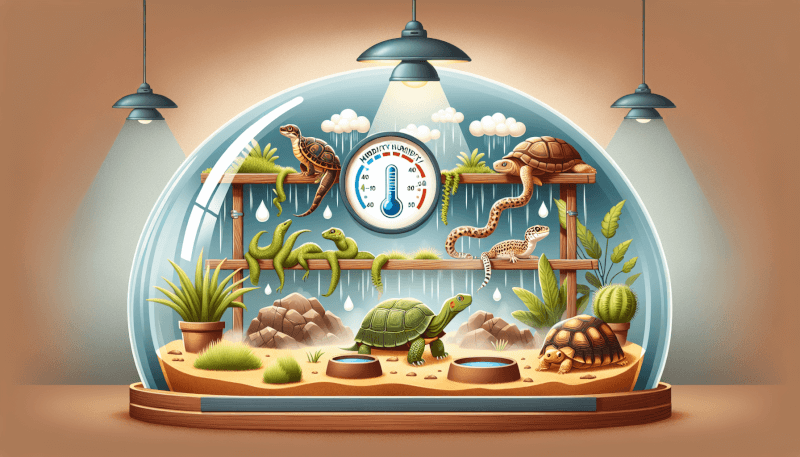
Common Mistakes and Misconceptions about Humidity
Overhydration and excessive misting
A common mistake regarding humidity is overhydration and excessive misting. Some reptile owners mistakenly believe that constant misting or excessive humidity is beneficial to reptiles. However, this can lead to stagnant moisture, bacterial and fungal growth, and respiratory problems. Proper monitoring and maintaining the ideal humidity range are essential to avoid these issues.
Underestimating the importance of humidity
Another common misconception is underestimating the importance of humidity for reptiles. Reptiles have evolved to rely on their environment for thermoregulation and hydration. Neglecting proper humidity levels can result in significant health problems and compromises the well-being of the reptiles. Understanding and prioritizing the humidity requirements of reptiles is crucial for responsible reptile husbandry.
Relying solely on temperature control
While temperature control is important in reptile care, it should not overshadow the significance of humidity. Reptiles require both appropriate temperature and humidity levels to thrive. Neglecting or overlooking humidity requirements can lead to health issues, even if the temperature is within the optimal range. Balancing temperature and humidity is crucial for creating a suitable and healthy environment for reptiles.
Using inaccurate or unreliable measuring methods
The use of inaccurate or unreliable measuring methods is a common mistake that can lead to incorrect humidity readings. Relying on touch or visual assessments alone may not provide accurate information about humidity levels. It is essential to invest in reliable tools such as hygrometers to obtain precise and consistent humidity readings. This ensures that appropriate adjustments can be made to maintain optimal humidity for reptiles.
Seeking Professional Guidance for Humidity Control
Consulting with a reptile veterinarian or herpetologist
If reptile owners have concerns or are unsure about maintaining proper humidity levels, consulting with a reptile veterinarian or herpetologist is highly recommended. These professionals have the expertise and knowledge to provide specific guidance tailored to individual reptile species. They can offer insights on proper husbandry practices, identify potential issues, and provide valuable advice on maintaining optimal humidity.
Specialized reptile forums and communities
Specialized reptile forums and online communities are valuable resources for seeking guidance on humidity control. Reptile enthusiasts, experienced keepers, and breeders often share their knowledge and experiences in these forums. Engaging in discussions, asking questions, and learning from others’ experiences can help reptile owners gain a deeper understanding of humidity requirements and practical humidity control methods.
Reputable reptile care resources
Reputable reptile care resources, such as books, articles, and online publications, are excellent sources of comprehensive information on humidity control. These resources often provide detailed guidelines and tips for maintaining proper humidity levels in reptile enclosures. It is important to ensure that the sources are from trusted and reliable authors or organizations to ensure accurate and up-to-date information.
Working with experienced reptile keepers
Establishing connections and seeking advice from experienced reptile keepers can be immensely valuable. Reptile keepers who have successfully maintained healthy and thriving reptiles can offer practical tips and suggestions based on their firsthand experiences. Learning from experienced keepers can provide insights into successful humidity control practices and help avoid common pitfalls.
Maintaining proper humidity levels in your reptile’s enclosure is essential for their health and well-being. Understanding the importance of humidity, monitoring and measuring humidity levels, creating and maintaining optimal humidity, and addressing humidity-related issues are all crucial aspects of providing an appropriate environment for your reptile. By taking the time to properly manage humidity, you are ensuring the overall health and longevity of your scaly friend. Remember, seeking professional guidance, using reliable resources, and learning from experienced keepers are all valuable tools in your journey to provide the best humidity control for your reptile companion.
